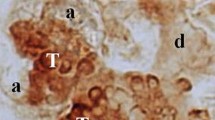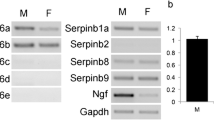Abstract
In the normal parotid glands of mice at 12 weeks of age, mK1, a true tissue kallikrein, was detected at the apical rim of the striated ducts (SDs). Sexual dimorphism in the immunostaining intensity in parotid glands was seen, i.e., immunostaining was more intense in males than in females. Under electron microscopy, secretory granules, being small in size, and condensed at the subluminal cytoplasm, were labeled with immunogold particles showing the presence of mK1. These secretory granules were rather abundant and large in males. Castration in males reduced the immunoreactivity of mK1 in the SD cells because of a decrease in the number and size of secretory granules as revealed by electron microscopy. Hypophysectomy in male mice resulted in considerable loss of immunoreactivity for mK1, which was characterized under electron microscopy by complete disappearance or significant reduction of secretory granules in many SD cells. These results suggest that mK1 expression in the SD cells of murine parotid glands is regulated by pituitary-dependent hormones, and sexual dimorphism of mK1 expression is regulated by androgens.
Similar content being viewed by others
Author information
Authors and Affiliations
Corresponding author
Rights and permissions
About this article
Cite this article
Kurabuchi, S., Hosoi, K. Immunocytochemical localization of mK1, a true tissue kallikrein, in the mouse parotid gland: sexual dimorphism and effects of castration and hypophysectomy. Odontology 92, 73–76 (2004). https://doi.org/10.1007/s10266-004-0040-7
Received:
Accepted:
Issue Date:
DOI: https://doi.org/10.1007/s10266-004-0040-7




